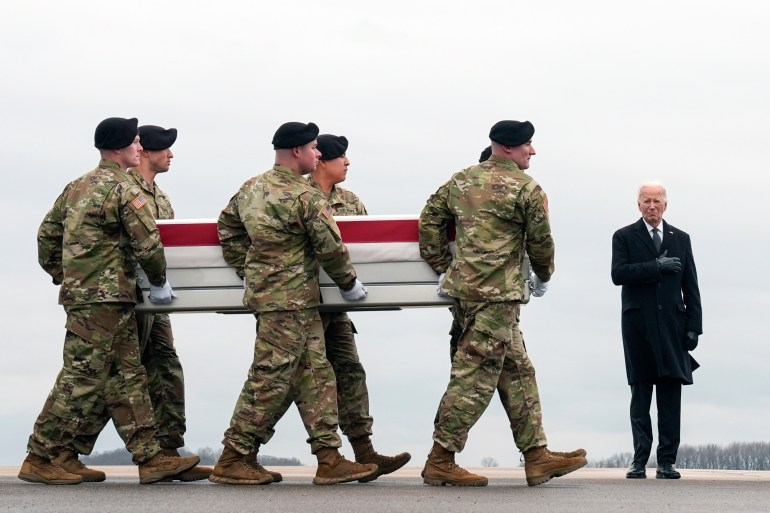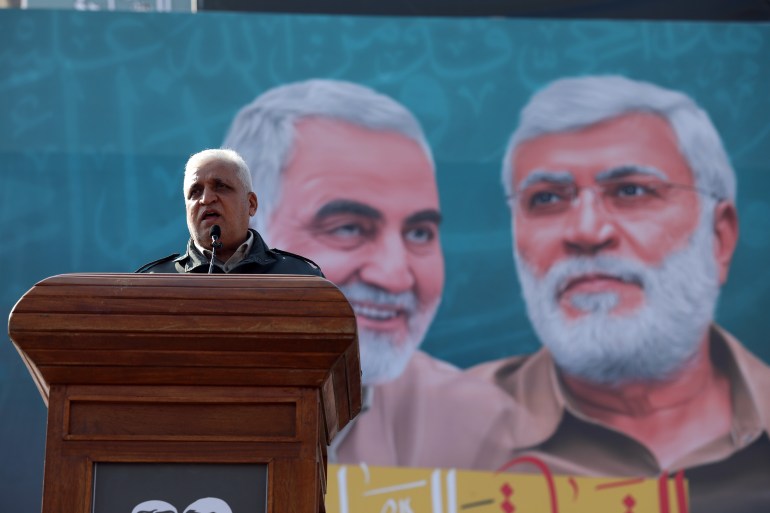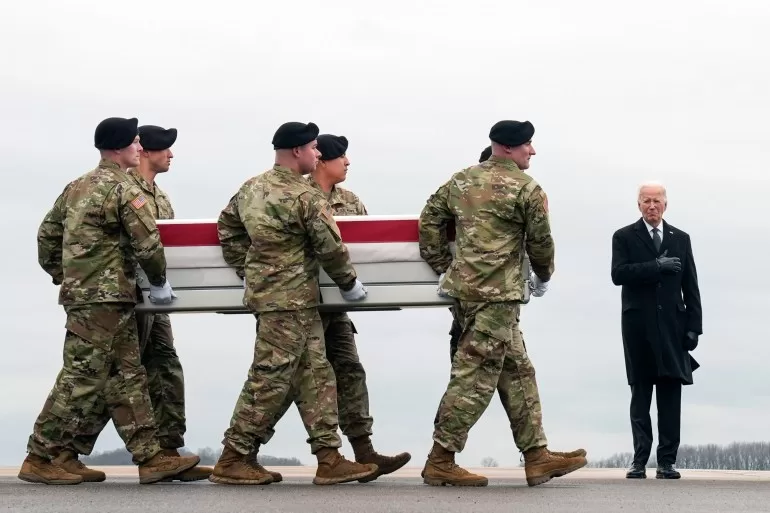Three men from Kataib Hezbollah, part of a coalition of militias-turned-state apparatus called the Popular Mobilisation Forces (PMF), were killed in the US strike, including Wissam Mohammed, the commander in charge of Kataib Hezbollah’s operations in Syria, who went by the nom de guerre Abu Bakr al-Saadi.
On January 28, a drone had struck a Jordanian-US outpost called Tower 22 and killed three US soldiers. The Islamic Resistance in Iraq (IRI), an umbrella group of Iran-backed armed groups in the region, claimed responsibility for the attack, saying it was carried out in response to US support for Israel’s war on Gaza.
But Pentagon spokesperson Sabrina Singh said the drone attack bore the “footprints” of Kataib Hezbollah, adding, “We know Iran is behind it” but not presenting evidence. Iran has denied any involvement in the assault.
In recent months, Iranian-backed groups in Iraq and Syria operating under the banner of the IRI have launched about 170 attacks on US bases. But the attack on Tower 22 was the first to result in the deaths of US military personnel since October 18, the Pentagon said, adding that 143 Americans have been injured overall.
The situation has led to what analysts described as a tit-for-tat exchange of fire between the US and Iran-backed groups in the region.
On January 4, a US air strike in Baghdad killed Mushtaq Jawad Kazim al-Jawari, aka Abu Taqwa, a commander in Harakat Hizballah al-Nujaba, another PMF militia. The US said he had been involved in attacks on American personnel.
“There has been an escalation in frequency but also in casualties,” Renad Mansour, a senior research fellow at the Chatham House think tank’s Middle East and North Africa Programme, told Al Jazeera. “And at the same time, this is not new. There have been moments in the past where this tit-for-tat has occurred.”

A scramble for influence
Over the years since the 2003 US invasion of Iraq, a battle has played out in the country between Iran and the US for government influence. Among those working in alignment with Iran are a number of members of the PMF, a coalition of paramilitary groups that emerged in 2014 to fight ISIL (ISIS).
In 2017, the PMF’s legitimacy was codified into law against the wishes of the Iraqi Ministries of Interior and Defence, and they were brought under the oversight of Iraq’s national security adviser.
The main targets of US-led assassinations have been commanders in various Iraqi government-linked PMF groups. These many paramilitaries include pro-Iranian militias and some nationalist militias although in recent years the pro-Iranian faction has diluted the nationalist influence. The PMF’s leader, Faleh al-Fayyad, recently demanded that the US-led coalition withdraw from Iraq and warned that “targeting the PMF is playing with fire”.
Despite the PMF’s anti-American delineation, recent attacks on the US have been credited to the Islamic Resistance in Iraq instead.
The IRI is a vanguard group of armed actors from within the PMF that operates in Iraq and Syria but does not necessarily fall under the PMF’s chain of command. Despite being closely aligned with Iran, it at times act in its own interests and with its own agency.
“The real objective of these attacks is to force the Americans to withdraw from Iraq and Syria,” Randa Slim, a senior fellow at the Middle East Institute, told Al Jazeera.
The banner of the IRI is useful for both the PMF and the US, analysts said. This way, actors from the PMF and the US can trade attacks without directly implicating their partners in the Iraqi government.
Members of the IRI “are on the front line and at times perform the violence on behalf of the wider networks connected to the PMF or Iran, which often prefer deniability”, Mansour said. “Therefore, when something goes wrong, the PMF is not necessarily implicated, even though they fall under the same umbrella group.”

Saving face for Iraq
After the attack on Tower 22, Kataib Hezbollah released a statement saying it would cease attacks on US interests in the region to keep from embarrassing the Iraqi government, of which the PMF is now officially an extension.
But “it was an embarrassment to the Iraqi government to put that in the public statement in itself,” Slim said.
Whether Kataib Hezbollah resumes operations in response to Wednesday night’s assault by the US remains to be seen. The US has repeatedly stated it is trying to avoid a wider regional war despite many actors in the region declaring that their actions are connected to US backing of Israel’s war on Gaza.
Analysts said the recent US actions amount to an intensification but were also to be expected after the killing of US military personnel.
“The red line for the American presidents, including [Donald] Trump, has always been the death [of US soldiers],” Slim said.
But the US government may be strategically backing itself into a corner. Domestically, President Joe Biden has come under pressure from parts of the Washington establishment to respond with strength against these attacks.
Some have even called for direct attacks on Iran, such as Senator Lindsey Graham who, after the Tower 22 attack, said: “Hit Iran now. Hit them hard.”
However, repeated assassinations, targeting of PMF weapons depots and increased US sanctions have had little impact on the Iran-backed groups’ behaviour.
“The problem for the US is that their policy options and strategic thinking are often limited and incoherent so as to make its approach ineffective,” Mansour said.
“The US has killed senior leaders from these resistance groups – including Qassem Soleimani and Abu Mahdi al-Muhandis, who was the leader of Kataib Hezbollah – and yet these groups are still operating and still moving back and forth between the [Syrian and Iraqi] borders.
“One has to wonder if it would work or how it would look because, until now, the kinetic response of American intervention against Islamic resistance groups hasn’t altered their behaviour or weakened their influence.
“On the contrary, they’ve become more powerful since.”
